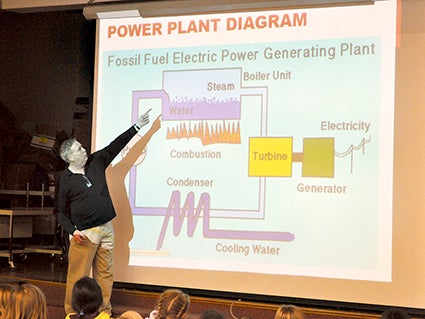Aligning science and kids; Science Fair Mentoring enters third year
Published 11:18 am Monday, November 7, 2016

- Dr. Gareth Hataye, an Austin optometrist, discusses the polycarbonate make up of lenses during the Science Fair Mentoring kickoff Thursday at the Neveln Elementary School. Photos by Deb Nicklay/deb.nicklay@austindailyherald.com
The third year of the Science Fair Mentoring program at Neveln Elementary School on Thursday got underway, with four local scientists on hand to chat with kids and talk about how a love of science led to their own livelihoods.
All of it is part of a project that matches adult scientists with kids, said Catherine Haslag, the volunteer who established the program in 2014.
Exciting this year, she added, is a pilot program being conducted at Banfield Elementary School.
The adult mentors guide pairs of students through the Science Fair process. The culmination will be in February, when the students will present their project at the local Science Fair.
On Thursday, Dr. Rebecca Morris of the Hormel Institute, Dr. Gareth Hataye of InnoVision Eye Care in Austin, Richard Lemons a retired electrical engineer; and Chuck Meyer, a science instructor at Riverland Community College, all spoke to the students.

Dr. Rebecca Morris of the Hormel Institute, working in stem cell research and discussed her early love of science during the Science Fair Mentoring kickoff Thursday at the Neveln Elementary School.
Morris is working in stem cell research and discussed her early love of science — developing so early that she cannot recall building a washing machine for a doll, but only heard about it from her family.
Lemons took the students through the processes of a power plant. Hataye, an optometrist, showed the students the impact resistance of polycarbonate lenses — to the students’ delight, he did it with a hammer. Meyer brought some of his favorite “pieces” of science — including pieces of a rock collection.
Haslag is a chemistry instructor at Riverland who was donating her time to being a Science Fair judge when she thought of the idea of having a mentoring project.
“I noticed that some kids needed help with their projects who weren’t getting it,” she said. At the same time, she knew that Austin was the center of some serious scientific talent, as home of Hormel Food, The Hormel Institute, Riverland Community College and Mayo Clinic Health System-Austin.
There has been impact, she added.
In 2014, less than 10 percent of the students eligible for Science Fair were participating, she said. Last year, almost 42 percent were involved.
She said a partnership of sponsors, school officials, volunteers and teachers have worked together to make the project work.
“We have incredible support,” she said.

Richard Lemon, an electrical engineer, takes Neveln Elementary School third and fourth graders through how a power plant generates electricity during the Science Fair Mentoring kickoff on Thursday.





